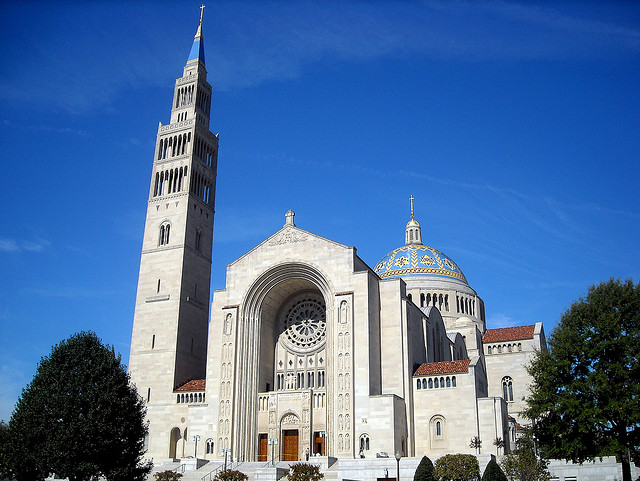by Annie Waldman ProPublica, Sep. 22, 2015, 11:33 a.m.
Update, Sept. 24, 2015: We have added a reference to a Hechinger Report story that also explored the lack of financial aid at Catholic schools.
Pope Francis has made serving the poor a central tenet of his papacy. “Wealth makes us poor,” he told Cuban worshippers on Sunday, urging them not to forget “the smallest, the most abandoned.”
As the pope makes his first visit to the United States, he might want to reiterate that message to the nation’s Catholic colleges.
Six of the top 20 nonprofit colleges that are most expensive for low-income students are Catholic institutions, according to a ProPublica analysis of recently released federal data. At almost half of all Catholic colleges, low-income students graduate with more than $20,000 in federal loans. (See our Debt by Degrees interactive, which shows how American colleges compare in how much federal student loan debt students accumulate.)
At Catholic University of America in Washington D.C., where Pope Francis is scheduled to speak on Wednesday, the school’s poorest students pay over $31,000 a year in tuition, even after discounts from scholarships – more than any other research university in the nation. Students also graduate with a significant amount of debt: $26,000. And just 12 percent of its students are low-income.
Gerald Beyer, a Christian ethics professor from Villanova University said schools should be doing more. “Empowering the poor is a key part of Catholic social teaching, and education is an essential means of achieving this goal,” he said. “Catholic institutions need to rethink their own policies.”
Several schools, including Catholic University, said financial struggles have limited their ability to provide aid. Catholic University recently laid off a handful of staff members. The school also points to its relatively modest endowment: $308 million.
“We are unfortunately not a school with an endowment that starts with a B,” said Christopher Lydon, vice president for enrollment management and marketing at Catholic University. (Last year, the Hechinger Report also explored the lack of financial aid to poor students at Catholic University and other Catholic schools.)
Notre Dame, Boston College, and Georgetown – all Catholic schools with endowments worth more than a billion dollars – offer more generous financial aid to their poorest students.
But like Catholic University, the schools don’t enroll many of them. The percentage of students who receive Pell grants – federal grants for students whose families typically earn under $30,000 – is less than 14 percent at each of the schools. Nonprofit four-year colleges on average have around 40 percent Pell grant recipients.
The wealthier Catholic universities say that they are working hard to enroll more low-income students. Georgetown and Boston College have need-blind admissions and guarantee to meet the full needs of students through financial aid.
Notre Dame, which has an $8 billion endowment, recently announced a $20 million fund to cover college expenses for low-income students. The school also has begun to enroll undocumented students and give them funds to match Pell grants, for which they are ineligible.
“Notre Dame is devoting considerable resources to attracting and, as importantly, supporting students from low socioeconomic households,” said the school’s spokesman, Dennis K. Brown.
Some Catholic universities with modest resources stand out for serving the poor.
Just down the road from Catholic University sits Trinity Washington, which has some well-known graduates, including Rep. Nancy Pelosi. The women’s university has a tiny $11 million endowment. But nearly 65 percent of its students receive Pell grants. The poorest students graduate with on average $16,000 of debt from federal loans.
Trinity Washington’s president, Patricia McGuire, believes that other Catholic schools should follow a similar path.
“There’s a whole group of schools that want to be in the Ivy Leagues and want to be considered prestigious, and then there’s the rest of us who believe education is not about competition,” said McGuire. “Every institution needs to examine its own conscience about whether it could do more for students on the margins.”
Anthony Carnevale, a professor at Georgetown and the director of the university’s Center on Education and the Workforce, says the lack of low-income students is being driven by college ratings and competition for high-performing applicants.
“Christianity, let alone Catholicism, is supposed to be about taking care of each other and throwing the money changers out of the temple, but Jesus didn’t have to run a college,” said Carnevale. “The only way for colleges to survive is to become more and more selective, and in this country, it means whiter and wealthier.”
Update, Sept. 25, 2015: After this article published, the Association of Catholic Colleges and Universities offered a statement saying that the article “presented a biased and inaccurate depiction of Catholic higher education in the United States.” It does not assert any misstatements of fact. Here is the association’s full statement.
ProPublica is a Pulitzer Prize-winning investigative newsroom. Sign up for their newsletter.

